
Earth Surface Dynamics
Scope & Guideline
Charting the Course of Earth’s Evolving Landscape
Introduction
Aims and Scopes
- Geomorphological Processes and Modeling:
The journal publishes research that explores the mechanisms and models governing landform evolution, including sediment transport, erosion, and deposition processes across various environments. - Remote Sensing and Geospatial Analysis:
Utilizing satellite imagery and aerial data, studies in this journal often apply remote sensing techniques to monitor and analyze landscape changes, providing insights into the spatial and temporal dynamics of earth surface processes. - Climate and Environmental Interactions:
Research focusing on the interplay between climatic factors and geomorphological processes is prominent, addressing how changing climates influence erosion, sediment transport, and landscape stability. - Natural Hazards and Risk Assessment:
The journal covers studies related to natural hazards, including landslides, floods, and coastal erosion, emphasizing risk assessment methodologies and the implications for land management and disaster preparedness. - Innovative Analytical and Computational Techniques:
Papers often introduce or utilize advanced analytical methods, including machine learning and statistical modeling, to enhance our understanding of geomorphic systems and improve predictive capabilities.
Trending and Emerging
- Machine Learning Applications in Geomorphology:
The integration of machine learning techniques for analyzing geomorphic data and predicting landscape changes is increasingly prominent, showcasing the potential for automation and enhanced accuracy in earth surface research. - Impact of Anthropogenic Activities on Geomorphology:
Research examining the effects of human activities, such as land use change, urbanization, and resource extraction, on geomorphological processes is gaining importance, highlighting the critical intersection of environmental science and societal impacts. - Interdisciplinary Approaches to Earth Surface Dynamics:
There is a growing trend towards interdisciplinary research that combines geomorphology with fields like ecology, hydrology, and urban planning, reflecting the complexities of modern environmental challenges. - Advanced Remote Sensing Techniques:
The use of high-resolution satellite imagery and UAV technology to monitor and model geomorphic processes is on the rise, enabling more detailed and frequent assessments of landscape dynamics. - Resilience and Adaptation Studies:
Emerging research is focusing on the resilience of landscapes to natural hazards and climate change, emphasizing adaptive strategies for sustainable management of earth surface processes.
Declining or Waning
- Traditional Field-Based Studies:
There has been a noticeable decline in purely observational studies relying solely on traditional fieldwork methods, as the emphasis shifts toward integrating remote sensing and modeling techniques for more comprehensive analyses. - Static Erosion and Sediment Transport Models:
Simplistic, static models of erosion and sediment transport are becoming less common, with a growing preference for dynamic, process-based models that account for variability in environmental conditions and anthropogenic influences. - Generalized Climate Change Impact Studies:
While climate change remains a significant topic, research focusing on generalized impacts without specific regional or process-oriented insights is waning, as more targeted studies that examine localized effects gain traction.
Similar Journals
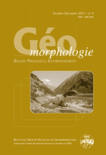
Geomorphologie-Relief Processus Environnement
Advancing Insights into Relief and EnvironmentGeomorphologie-Relief Processus Environnement is a pivotal journal in the field of Earth-Surface Processes, published by the GROUPE FRANCIAS GEOMORPHOLOGIE in France. With an ISSN of 1266-5304 and E-ISSN 1957-777X, the journal has established a notable presence since its inception in 1995. Though it operates without Open Access, it remains an essential resource, particularly in the niche area of geomorphology where it offers valuable insights into the interactions between relief features and environmental processes. The journal achieved a Q3 ranking in 2023 among Earth-Surface Processes, attesting to its significance in advancing research and discussions within this discipline, while it ranks #113/179 in Scopus, placing it in the 37th percentile. By fostering interdisciplinary dialogue and disseminating high-quality research, Geomorphologie-Relief Processus Environnement serves as a vital platform for researchers, professionals, and students eager to explore the complexities of our planet's surface processes.
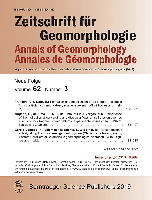
ZEITSCHRIFT FUR GEOMORPHOLOGIE
Advancing Knowledge in Geomorphological Processes.ZEITSCHRIFT FUR GEOMORPHOLOGIE is a prestigious journal dedicated to the field of geomorphology, published by GEBRUDER BORNTRAEGER from Germany. With the ISSN 0372-8854 and E-ISSN 1864-1687, this journal serves as a vital platform for researchers, professionals, and students interested in understanding the dynamic processes that shape our Earth’s surface. The journal has consistently maintained a solid academic reputation, achieving a Q3 ranking in key categories including Earth and Planetary Sciences (miscellaneous), Earth-Surface Processes, and Geography, Planning and Development as of 2023. This reflects its position within the global scientific community; ranked at #93 out of 179 in Earth-Surface Processes, contributing to crucial discussions surrounding environmental changes and landform evolution. Although ZEITSCHRIFT FUR GEOMORPHOLOGIE is not an Open Access publication, it offers extensive insights and findings from converged years spanning from 1979 to 2019 and again from 2021 to 2022. The journal is located at Johannesstr 3A, D-70176 Stuttgart, Germany, and plays a pivotal role in advancing geomorphological research that impacts natural sciences, ecology, and planning strategies worldwide.

Geofizika
Charting New Territories in Earth SciencesGeofizika, an esteemed journal published by the Andrija Mohorovičić Geophysical Institute at the University of Zagreb, presents a significant platform for research in the fields of geophysics and Earth sciences. With an Open Access model established since 1984, this journal ensures that scientific knowledge is accessible to a broad audience, encouraging collaborations and the free exchange of ideas. Geofizika has steadily evolved through its converging years from 1989 to 1999 and has been active from 2003 to the present, reflecting its commitment to advancing geophysical research. The journal has been recognized for its contributions to Earth and Planetary Sciences and has acquired respectable ranks in various categories; notably, it holds a Q4 status in Geophysics as of 2023. Researchers, professionals, and students will find Geofizika a valuable resource for the latest discoveries and methodologies in geophysics, supporting the academic community in expanding the frontiers of knowledge in these vital scientific domains.

Journal of Indian Geophysical Union
Advancing Knowledge in Geophysical SciencesThe Journal of Indian Geophysical Union, published by the Indian Geophysical Union (IGU), serves as a vital platform for disseminating research in the field of geophysics. With the ISSN 0257-7968, this journal primarily focuses on studies related to geophysical sciences, including but not limited to, seismicity, environmental geophysics, and geodynamics, contributing to a better understanding of the Earth's processes. The journal is committed to quality research and aims to foster a collaborative environment for researchers, professionals, and students in India and internationally. Although currently not designated as an Open Access publication, it plays an essential role in connecting academia with practical applications in geophysical research. Based in Hyderabad, India, the Journal of Indian Geophysical Union continues to be an essential resource for those seeking to expand their knowledge and engage with the latest findings in geophysics.

Geofizicheskiy Zhurnal-Geophysical Journal
Illuminating Complex Geophysical ChallengesGeofizicheskiy Zhurnal-Geophysical Journal, published by the esteemed S I Subbotin Institute of Geophysics, National Academy of Sciences of Ukraine, stands as a vital resource for professionals and researchers in the field of geophysics. With an ISSN of 0203-3100 and an E-ISSN of 2524-1052, this journal is recognized for its rigorous peer-reviewed articles that delve into various aspects of geophysical research, including seismic studies, geodynamics, and Earth surface processes. Although currently not under an open access model, the journal maintains a commitment to disseminating high-quality research, thereby enriching the global geophysical community. The publication aims to foster collaboration and knowledge transfer among scientists and engineers while addressing complex geophysical challenges in a rapidly evolving landscape. By engaging with cutting-edge research, readers can expect to uncover insights that advance both theoretical understanding and practical applications in geophysical science.
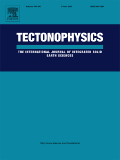
TECTONOPHYSICS
Driving Knowledge Forward in Earth and Planetary SciencesTECTONOPHYSICS is a leading journal published by Elsevier that has been at the forefront of earth and planetary sciences since its inception in 1964. With both its print and e-ISSN identifiers (0040-1951 and 1879-3266), the journal offers a reputable platform for disseminating high-quality research in Earth-Surface Processes and Geophysics, proudly positioned in the Q1 category for both fields in 2023. With a Scopus ranking of #43 out of 179 in Earth-Surface Processes and #43 out of 165 in Geophysics, TECTONOPHYSICS demonstrates a strong impact, making it an essential resource for researchers and professionals involved in the geological and geophysical sciences. Published in the Netherlands, TECTONOPHYSICS is committed to advancing knowledge in tectonics and related disciplines, fostering innovative research that impacts our understanding of Earth's dynamic processes. The journal invites contributions that push the boundaries of science, making it a must-read for academia and industry alike.
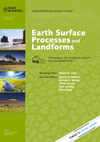
EARTH SURFACE PROCESSES AND LANDFORMS
Transforming Understanding of Earth’s Surface DynamicsEARTH SURFACE PROCESSES AND LANDFORMS is a renowned academic journal dedicated to the comprehensive exploration of dynamic processes shaping the Earth's surface. Published by Wiley, this esteemed journal has established itself as a leading platform in the fields of Earth and Planetary Sciences, Geography, Planning, and Development. With an impressive Impact Factor and ranked in the Q1 category for multiple disciplines, it consistently features cutting-edge research that contributes to the understanding of geomorphology, hydrology, and related environmental phenomena. Researchers and professionals can benefit from the journal's extensive repository of high-quality studies, making it a crucial resource for advancing knowledge in these vital areas. As it continues to converge from 1981 to 2024, EARTH SURFACE PROCESSES AND LANDFORMS remains pivotal for scholars aiming to engage in high-level discourse and discovery in Earth sciences.
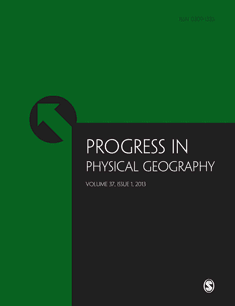
Progress in Physical Geography-Earth and Environment
Empowering scholars to navigate Earth’s changing landscapes.Progress in Physical Geography-Earth and Environment is a premier academic journal published by SAGE Publications Ltd, renowned for its contributions to the fields of Earth and Planetary Sciences and Geography. With a distinguished history spanning from 1977 to 2024, this journal maintains a robust Q1 classification in both Earth and Planetary Sciences and Geography, Planning and Development, reflecting its high impact and rigorous scholarly standards. As evidenced by its Scopus rankings, it stands at the forefront of research, positioned in the 89th percentile among leading journals. Progress in Physical Geography aims to facilitate the exchange of innovative research, insights, and methodologies, making it an essential resource for researchers, professionals, and students dedicated to understanding and shaping the natural environment. While currently not designated as an Open Access journal, the wide accessibility of its content, combined with its significant impact factor, underscores its importance within the academic community seeking to advance knowledge and application in geography and environmental sciences.
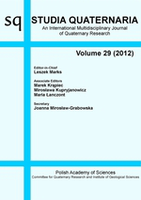
Studia Quaternaria
Advancing knowledge of Earth's dynamic processes.Studia Quaternaria is a leading academic journal published by the Polish Academy of Sciences, Institute of Geological Sciences, specializing in the dynamic fields of Earth-Surface Processes and Geology. With an ISSN of 1641-5558 and an E-ISSN of 2300-0384, this journal has been a prominent platform for scholarly discourse since its inception in 2000. Operating under the open-access model, it aims to disseminate high-quality research that is accessible to a global audience. Studia Quaternaria holds a Q3 ranking in both relevant quartiles as of 2023, indicating its commitment to advancing knowledge in its disciplines despite centering in competitive academic environments. With its publications indexed in Scopus, the journal remains a valuable resource for researchers, professionals, and students looking to stay abreast of innovations and discoveries in Earth-Surface Processes and Geology. Encompassing a broad scope of studies, the journal represents an essential contribution to the geological sciences, fostering a deeper understanding of our planet's changes and processes.

Journal of Asian Earth Sciences-X
Fostering Collaboration for Sustainable Earth SolutionsJournal of Asian Earth Sciences-X, a distinguished publication by ELSEVIER, is at the forefront of Earth and planetary sciences, particularly focusing on the dynamic fields of geology and earth-surface processes. As an Open Access journal since 2019, it provides unparalleled access to high-quality research, fostering global collaboration and dissemination of knowledge. With an impressive impact factor and ranking in the Q2 category for both Earth-Surface Processes and Geology, it serves as a crucial platform for researchers, professionals, and students alike to share their findings and insights. Situated in the United Kingdom, the journal thrives on contributions that enhance our understanding of Asian geosciences within a broader global context, aiming to tackle major challenges such as climate change and natural resource management. By bridging regional studies with global perspectives, the Journal of Asian Earth Sciences-X is not only a vital resource for academia but also supports sustainable development initiatives across the region.